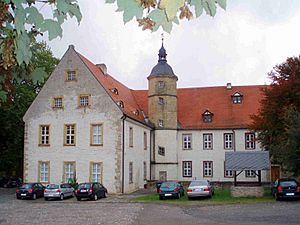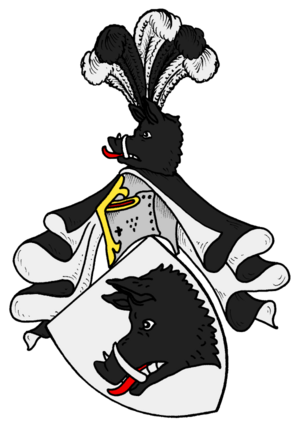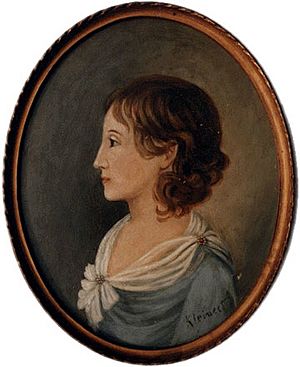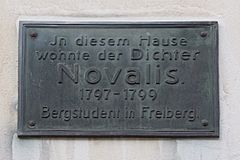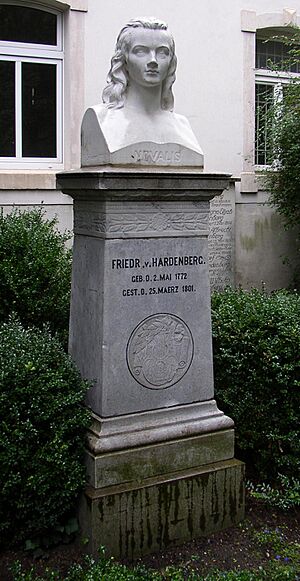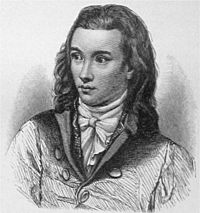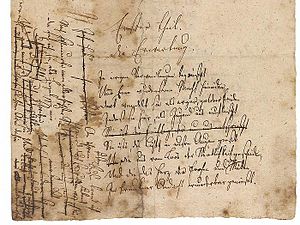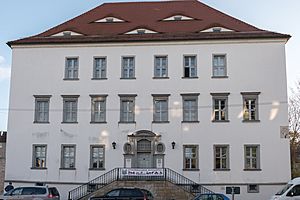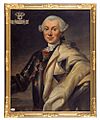Novalis facts for kids
Quick facts for kids
Novalis
|
|
|---|---|
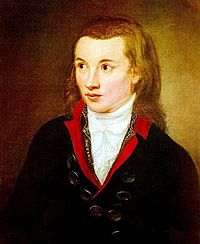
1799 portrait of Novalis
|
|
| Born | Georg Philipp Friedrich Freiherr von Hardenberg 2 May 1772 Wiederstedt, Electorate of Saxony |
| Died | 25 March 1801 (aged 28) Weissenfels, Electorate of Saxony |
| Pen name | Novalis |
| Occupation | Writer, philosopher, poet, aristocrat, mystic, mineralogist, civil engineer |
| Nationality | German |
| Alma mater | University of Jena Leipzig University University of Wittenberg Mining Academy of Freiberg |
| Period | 1791–1801 |
| Genre |
|
| Subject |
|
| Literary movement | Jena Romanticism |
| Signature | |
Georg Philipp Friedrich Freiherr von Hardenberg (born May 2, 1772 – died March 25, 1801) was a German writer. He is better known by his pen name, Novalis. He was a noble, a poet, a novelist, a philosopher, and someone interested in spiritual mysteries. He is seen as a very important person in the early Romantic movement in Germany.
Novalis was born into a noble family in Saxony. He was the second of eleven children. His family followed a strict religious faith called Pietism. He studied law at several universities. While at Jena, he published his first poem. He also became friends with the famous writer Friedrich Schiller. In Leipzig, he met Friedrich Schlegel, who became a lifelong friend.
Novalis finished his law degree in 1794. He then worked as a legal assistant. There, he met Sophie von Kühn. They secretly got engaged the next year. Sophie became very ill and died shortly after her 15th birthday. Her early death deeply affected Novalis and his writing.
In 1797, Novalis went to the Freiberg University of Mining and Technology. He studied many subjects there. These included electricity, medicine, chemistry, physics, and mineralogy. He met many important thinkers of the Romantic period. After his studies, Novalis worked as a director of salt mines. During this time, he wrote famous poems like Hymns to the Night. In 1800, he became ill, possibly with tuberculosis. He died on March 25, 1801, at only 28 years old.
Novalis's friends published many of his works after his death. These included his poems, Hymns to the Night and Spiritual Hymns. They also published his unfinished novels, Heinrich von Ofterdingen and The Novices at Sais. His deeper knowledge in philosophy and science became known later. This happened when more of his notebooks were published in the 1900s. Novalis wanted to combine his knowledge with his art. He used a special writing style called the "fragment" to mix poetry, philosophy, and science.
Novalis's Life Story
His Early Years
Novalis was born Georg Philipp Friedrich von Hardenberg in 1772. His family lived at Schloss Oberwiederstedt in Saxony. This village is now part of Arnstein. His family was part of an old noble group.
His father, Heinrich Ulrich Erasmus von Hardenberg, owned the estate. He also managed salt mines. His mother was Auguste Bernhardine. Novalis was the second of eleven children. His family was not rich, even though they were noble.
Novalis's early schooling was very religious. His father was a member of the Moravian Church. He ran a strict, religious household. Novalis was taught by private teachers until he was nine. These teachers were trained in religious studies. He then went to a Moravian school for three years.
When he was twelve, Novalis lived with his uncle. His uncle, Gottlob Friedrich Wilhelm von Hardenberg, was a commander of the Teutonic Order. He lived on his estate in Lucklum. Novalis's uncle showed him a new world. He learned about new ideas from the Age of Enlightenment. He also read works by famous writers. These included Goethe and Shakespeare.
At seventeen, Novalis went to a high school in Eisleben. This town was near Weissenfels, where his family had moved. At school, he learned about public speaking and old literature.
University Studies
From 1790 to 1794, Novalis studied law at universities. He first went to the University of Jena. There, he studied philosophy. He also became very close friends with the writer Friedrich Schiller. Novalis went to Schiller's history classes. He also cared for Schiller when he was sick.
In 1791, Novalis published his first poem. It was called "Lament of a Youth." He dedicated it to Schiller. This made his father unhappy, so he moved Novalis to another university. The next year, Novalis went to the University of Leipzig with his younger brother. There, he met Friedrich Schlegel, a literary critic. Friedrich became one of Novalis's best friends. A year later, Novalis finished his law degree at the University of Wittenberg.
Meeting Sophie von Kühn
After graduating, Novalis moved to Tennstedt. He worked there as a legal assistant for Cölestin August Just. Just became his friend and later wrote about Novalis's life. In 1795, Novalis met 12-year-old Sophie von Kühn. At that time, girls her age could receive visitors.
He was immediately very taken with her. This meeting seemed to change his personality. Two days before Sophie turned thirteen, they secretly got engaged. Later, Sophie's parents agreed to the engagement. Novalis's brother supported them. But the rest of Novalis's family did not agree. They worried about Sophie's family background.
Novalis kept studying and writing while working in Tennstedt. He wrote six sets of notes about philosophy. These were later called Fichte Studies. He continued his philosophical studies in 1797.
Sophie's health began to get worse in late 1795. She had a liver tumor, possibly from tuberculosis. She had surgery without pain medicine. In January 1797, Novalis got a job at the salt works in Weissenfels. He moved there to earn money for his marriage. Sophie stayed with her family.
Sophie became very ill again. Novalis's parents finally agreed to the engagement. But two days after her fifteenth birthday, Sophie died. Novalis was still in Weissenfels. Four months later, his younger brother Erasmus also died from tuberculosis. Sophie's death, and his brother's, deeply affected Novalis. Their deaths made him write more poetry. Sophie's death inspired his famous work, Hymns to the Night.
Mining Studies and Later Life
At the end of 1797, Novalis joined the Mining Academy of Freiberg. He wanted to work at the salt mines in Weissenfels. He studied many subjects there. These included electricity, chemistry, physics, and mathematics. He also met many important people. He visited Goethe and August Schlegel. He also met the writer Jean Paul.
In December 1798, Novalis got engaged again. His fiancée was Julie von Charpentier. She was the daughter of a mining professor. Novalis's feelings for Julie grew slowly. He saw his love for her as more "earthly" than his love for Sophie. But his feelings for Julie later inspired some of his poems. Novalis and Julie stayed engaged until his death in 1801. She cared for him during his last illness.
Novalis continued his writing in Freiberg. He started a project to connect all the sciences. He wanted to combine his knowledge of science with his writing. This can be seen in his unfinished novel, The Novices at Sais. It used ideas from his studies to explore nature and understanding. He also thought about how mining could fit into his view of the world. This connection between science, philosophy, and literature appeared in his second unfinished novel, Heinrich von Ofterdingen.
Novalis also became known as a published author. In 1798, his short writings appeared in a magazine called Athenaeum. These included Pollen and Faith and Love. Pollen was the first work he published using his pen name, "Novalis." This name came from his ancestors. It also means "someone who cultivates new land." This showed how Novalis saw himself. He wanted to explore new ideas.
In early 1799, Novalis finished his studies. He returned to managing salt mines in Weissenfels. By December, he became a director of the salt mines. At the end of 1800, Novalis, at 28, was made a magistrate for the Thuringia district.
In 1799, Novalis met Ludwig Tieck. Tieck became one of his closest friends. They were part of a group called the Jena Romantics. This group was interested in philosophy, literature, and art. Novalis studied the works of a mystic named Jakob Böhme. He also read about philosophy and religion. These ideas inspired his essay, Christianity or Europe. He also wrote his Spiritual Songs and started his novel Heinrich von Ofterdingen.
From August 1800, Novalis began coughing up blood. Doctors thought he had tuberculosis. But some think he might have had cystic fibrosis. This is a genetic disease that might have caused many of his siblings to die young. After a bad bleed in November, he moved to Dresden for medical care. In January, he asked to be with his parents. He died in Weissenfels on March 25, 1801. He was buried in the Old Cemetery in Weissenfels.
Novalis's Impact
As a Romantic Poet
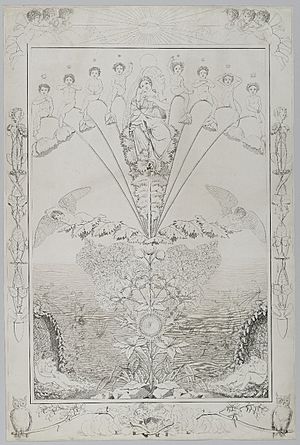
When Novalis died, he had only published a few works. Most of his writings were not finished or published. This makes it hard to fully understand his work. His unfinished novels and many poems were published by his friends. But they did not publish all of his philosophical writings. A full collection of his notes was not available until the 1900s.
In the 1800s, people mostly saw Novalis as a poet. They thought he was a passionate person who grieved for his lost love. He was known as the poet of the "blue flower." This flower was a symbol of romantic longing from his novel Heinrich von Ofterdingen. It became a key symbol for German Romanticism. His friends also described him as a poet who dreamed of a spiritual world. Novalis's illness, tuberculosis, also added to his romantic image. Because Sophie also died from tuberculosis, people saw Novalis as the poet who was reunited with his love through death.
The idea of Novalis as a romantic poet became very popular. When his friend August Cölestin Just wrote about Novalis's life, he was criticized. Just had written that Novalis was also a hard-working mine inspector. People thought this did not fit the image of a romantic poet. Even the writer Thomas Carlyle, who introduced Novalis to English speakers, saw him as a mystic poet.
As a Deep Thinker
In the 1900s, Novalis's writings were collected more completely. These works showed that he was interested in more than just poetry. He also studied science, law, philosophy, and politics. He left many notes on these topics. His early works show how easily he moved between different fields. His later works also included topics from his job.
In his notebooks, Novalis thought about the meaning of his interests. He tried to connect all the different fields he studied. He wanted to create a single way of looking at the world.
Novalis's philosophical ideas often focused on nature. He explored how people can be free and creative. He believed this happens when people feel connected to the earth. In Pollen, Novalis wrote, "Our calling is the cultivation of the earth." He thought people understand themselves by experiencing nature. Novalis's novel Heinrich von Ofterdingen shows this idea. He used his knowledge of salt mining to understand human life. Some people even think Novalis's ideas could help us understand environmental problems today.
Magical Idealism
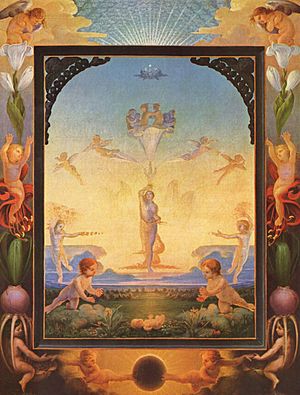
Novalis's way of seeing the world is called magical idealism. This name comes from his notes in 1798. He wrote about a "magical idealist." In this view, philosophy and poetry are connected. Magical idealism combines philosophical ideas with creative imagination. The goal is to break down barriers. It aims to connect language and the world, and the person and the object. The "magic" is when nature seems to respond to our thoughts.
Another part of Novalis's magical idealism is his idea of "love." For Novalis, love is a feeling of connection between everything in the world. He saw it as the basis and goal of magic. Novalis used "magic" to challenge modern thinking. He felt that modern thinking made the world less wondrous. But his use of "magic" and "love" also made readers pay attention. He wanted them to see how he used art, especially poetry, to explore nature.
Magical idealism also talks about health. Novalis believed that illness comes from a lack of balance. It's a disharmony between a person and nature. This "magic" is not from another world. It is based on how our body and mind relate to our surroundings. Novalis thought that health is kept when we use our bodies to feel the world. We should not try to control it. The goal is for people and nature to work together in harmony.
Religious Ideas
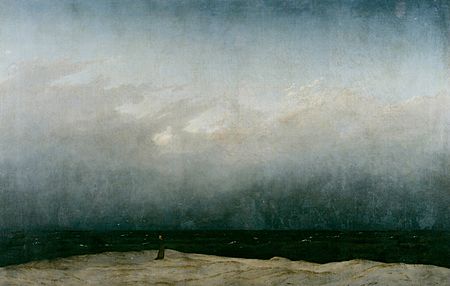
Novalis's religious views are still discussed today. His early religious upbringing deeply affected him. This is clear in his two main poems. Hymns to the Night has many Christian symbols. His Spiritual Songs were published after his death. They were even used in Lutheran hymn books. Novalis called them "Christian Songs."
One of his last works was called Christianity or Europe. It was published in full in 1826. This essay has caused much debate about his religious views. Novalis had simply called it Europa. It called for European unity by talking about a mythical golden age. This was a time when Europe was united under the Catholic Church.
Some people think Novalis's work shows a traditional Christian view. His brother said Novalis read the Bible during his last illness. Others, in the 1800s, thought Novalis was mostly Catholic in his thinking. In the 1900s, this view sometimes led to negative opinions of his work. Hymns to the Night was seen as an attempt to use religion to avoid modern problems. Christianity or Europe was called a desperate prayer or a dream of a religious government.
Another view is that Novalis's work shows Christian mysticism. After he died, his friends saw him as a visionary. They thought he aimed for a spiritual life. They believed he saw death as a way to reach God. In this view, Novalis was a visionary. He saw modern Christianity as a step to a higher religion. In this higher religion, earthly love becomes heavenly love. Death is defeated by love. More recently, Novalis's religious ideas have been looked at through his philosophy. His religious thoughts tried to combine different philosophical ideas.
Novalis believed that people could gain spiritual insight. But religion could still be logical. He thought God could be understood through reason. This idea also included Novalis's idea of love. In love, people and nature are united. Novalis wrote, "God is virtue itself."
This view suggests that Novalis's writings should be read carefully. His metaphors and images are not just mystical. They also express philosophical ideas. For example, Christianity or Europe is not just a call to return to the past. It is an argument, in poetic language, for a united Europe. It tries to connect the past and future, and ideals with reality.
Novalis's Writings
Poetry
Novalis is best known as a German Romantic poet. His two main poem collections are Hymns to the Night and Spiritual Songs. Hymns to the Night was started in 1797 after Sophie von Kühn died. A new version was published later. The Spiritual Songs were written in 1799 and published after his death. Many of these poems were put into Lutheran hymn books. Novalis also wrote other poems. Some English translations include:
- Hymns to the Night
- Translated by W. Hastie (1888)
- Translated by M. J. Hope (1891)
- Translated by George MacDonald (1897)
- Translated by Dick Higgins (1988)
- Spiritual Songs
- Translated by W. Hastie (1888)
- Translated by F. V. M. T. and U. C. B. (1903)
- Translated by George MacDonald (1897)
Unfinished Novels
Novalis wrote two unfinished novels. They are Heinrich von Ofterdingen and The Novices at Sais. Both were published after his death in 1802. These novels try to describe a world in harmony through poetry. The Novices at Sais includes the fairy tale "Hyacinth and Rose Petal." Heinrich von Ofterdingen is where Novalis introduced the "blue flower" symbol.
Novalis wrote Heinrich von Ofterdingen as a response to Goethe's Wilhelm Meister's Apprenticeship. Novalis liked Goethe's work but thought it was not poetic enough. He wanted his novel to be very poetic. Both of Novalis's novels use ideas from his science studies. They use metaphors to show human experience. English translations include:
- Heinrich von Ofterdingen
- Translated by Frederick S. Stallknecht and Edward C. Sprague (1842)
- Translated by M. J. Hope (1891)
- Translated by Palmer Hilty (1990)
- The Novices at Sais
- Translated by F. V. M. T. and U. C. B. (1903)
- Translated by Ralph Manheim (1949, 2005)
Fragments
Novalis and Friedrich Schlegel developed a writing style called the "fragment." For Schlegel, a fragment was like a piece of an old statue. It could make you imagine the whole thing. This style allowed Novalis to write about any topic he wanted. It helped him combine philosophy and poetry. His first major work in this style was Pollen, published in 1798. English translations include:
- Pollen
- Translated by Jakob Minor (1907)
- Translated by Alexander Gelley (1991)
- Translated by Margaret Mahoney Stoljar (1997)
Political Writings
Novalis wrote two works about politics. These were Faith and Love or the King and the Queen and his speech Europa. Both works argue for the importance of "faith and love" to unite people. Because these works are poetic, their meaning is still debated. Some see them as supporting old power structures. Others see them as dreams of human unity.
Faith and Love or the King and the Queen was published in 1798. It was written after King Wilhelm Frederick III and Queen Louise came to power in Prussia. Novalis wrote to the king and queen. He said they were important role models for creating a strong, connected state. The king stopped the publication of more parts. He felt it set standards that were too high for the monarchy.
Europa was written and first given to friends in 1799. It was not published in full until 1826. It is a poetic speech about history and a political ideal for the Middle Ages. Novalis wanted to create a new Europe based on a new Christian faith. He thought this would lead to unity and freedom. He was inspired by a book by Schleiermacher. This work was a response to the French Revolution. Novalis saw the revolution as a disaster. He wanted a new European spirituality and unity. Some English translations include:
- Faith and Love or the King and the Queen
- Translated by Jakob Minor (1907)
- Translated by Margaret Mahoney Stoljar (1997)
- Translated by Frederick C. Beiser (1996)
- Europa (later named Christianity or Europe)
- Translated by Charles E. Passage
- Excerpt translated by W. Hastie (1888)
- Excerpt translated by Catriona Seth (2017)
Other Works in English
Many of Novalis's philosophical and scientific works have been translated into English. Most of these were not fully collected until the 1900s. Their publication has led to a new understanding of Novalis as a thinker and artist.
- Philosophical and political works
- Monologue (translated by Fervit Güven)
- Writings of Novalis, Volume 2 (translated by Jakob Minor)
- Classic and Romantic German Aesthetics (translated by Joyce P. Crick)
- Novalis: Philosophical Writings (translated by Margaret Mahoney Stoljar)
- The Early Political Writings of the German Romantics (translated by Frederick C. Beiser)
- Notebooks
- Fichte Studies (translated by Jane Kellner)
- Novalis: Notes for a Romantic Encyclopaedia (translated by David W. Wood)
- Journals
- The Birth of Novalis: Friedrich von Hardenberg's Journal of 1797 (translated by Bruce Donehower)
Novalis's Influence
Novalis's ideas have influenced many people.
- The philosopher György Lukács used Novalis's idea that "Philosophy is really homesickness—the desire to be everywhere at home."
- The composer Richard Wagner used Novalis's ideas of Night and Day in his opera Tristan und Isolde.
- The writer Walter Pater quoted Novalis in his book Studies in the History of the Renaissance.
- The philosopher Rudolf Steiner talked about Novalis's influence on his ideas.
- The art critic Franz Roh might have been inspired by Novalis's "magical idealist" when he created the term magischer Realismus (magic realism).
- The philosopher Martin Heidegger used a Novalis quote in his book The Fundamental Concepts of Metaphysics.
- The author Hermann Hesse was influenced by Novalis's poetry.
- The artist Joseph Beuys's famous saying "Everyone is an artist" was inspired by Novalis.
- The author Jorge Luis Borges often mentions Novalis in his works.
- The German band Novalis took their name from him and used his poems as lyrics.
- Novalis Records, a music company, was named after his writings.
- The filmmaker Stan Brakhage made a short film called First Hymn to the Night – Novalis in 1994.
- The artist Chris Powell made an animated film called Novalis, where the main character is a robot named after him.
- The musician Erik Wøllo titled one of his songs "Novalis."
Images for kids
-
Caspar David Friedrich's Monk by the Sea (about 1808)
See also
 In Spanish: Novalis para niños
In Spanish: Novalis para niños


